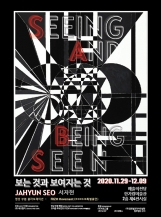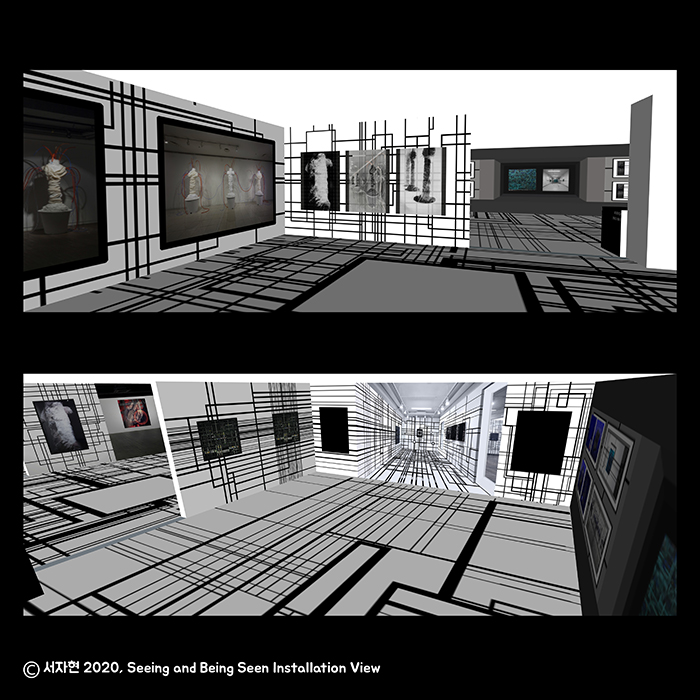서자현 : 보는 것과 보여지는 것(Seeing and Being Seen)
2020-11-29 ~ 2020-12-09
예술의전당 한가람미술관 2층 제4전시실
[전시개요]
전 시 명 : 보는 것과 보여지는 것 Seeing and Being Seen
전시작가 : 서자현 徐慈顯 Jahyun Seo
기 간 : 2020.11.29. - 12.09.
장 소 : 예술의전당 한가람미술관 2층 제4전시실
시 간 : 11:00 a.m. – 19:00 p.m. (매주 월요일 휴관)
관 람 료 : 성인: 15000원 / 청소년: 12000원 / 어린이: 10000원
주 최 : 세오컬처
후 원 : 바호그룹, 글로벌코리아컨설팅
[작가 소개]
Jahyun SEO 서자현
서자현은 파리 네프빌 꽁뜨 고등 예술학교(Ecole Superieure D art Neufville Conte)에서 창작텍스타일학과를 졸업한 후 홍익대학교에서 현대미술의 다층적평면구조에 대한 이론적 연구로 미술학 박사학위를 받았다. La Mama Galleria(뉴욕, 2017)를 비롯한 14회의 개인전을 하였고 200회 이상의 단체전에 참여하였다. 2016.07-2017.07 뉴욕의 Nars Foundation 아티스트 레지던시 프로그램을 일년간 참여 후 뉴욕, 브루클린의 J&M Studio에서 활동 중이다.
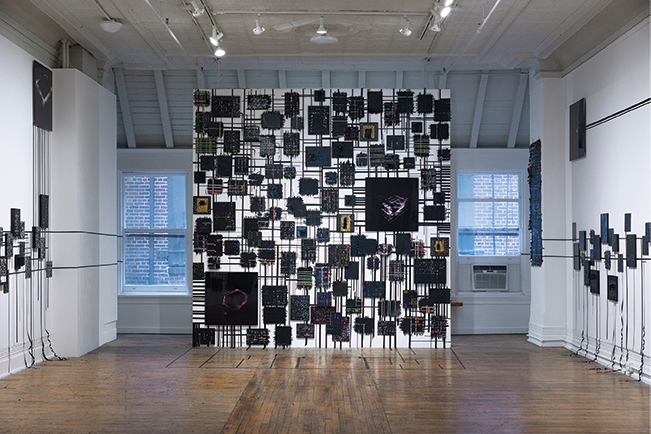 서자현, 보는 것과 보여지는 것, Installation View, 2017
서자현, 보는 것과 보여지는 것, Installation View, 2017
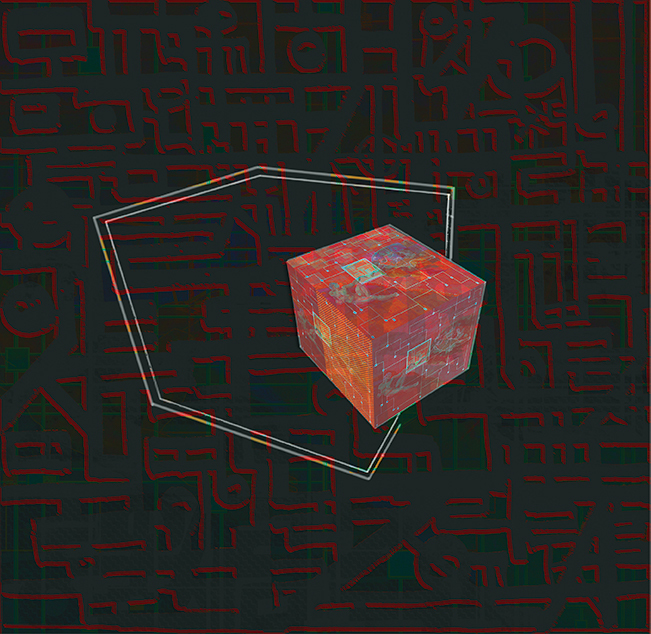 서자현, 천지창조35, Digital C-print, 102×102cm, 2020
서자현, 천지창조35, Digital C-print, 102×102cm, 2020
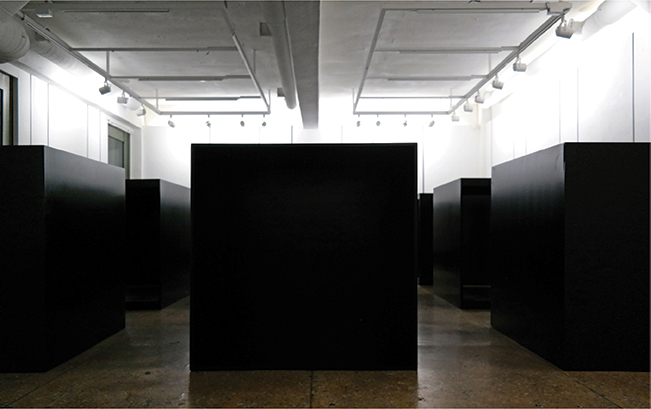 서자현, 사각 틀, Installation View, 2020
서자현, 사각 틀, Installation View, 2020
[관람포인트]
1. 작품 속 숨은 메시지 찾아내기
원본과 사본의 경계에서 생각하는 ‘보는 것’과 ‘보여지는 것’의 의미
서자현 작가는 아날로그 작품을 사진으로 담아내고, 다양한 그래픽 프로그램의 기능을 활용해 원본과는 완전히 다른 형상의 이미지를 만들어낸다. 아날로그 방식으로 제작된 원본, 그리고 이를 촬영한 사진과 다시 한번 컴퓨터 그래픽 프로그램을 거쳐 태어난 디지털 아트, 작가는 어떠한 것이 정답이고 좋은 것이라고 답을 정해 놓지 않는다. 다만 관람자로 하여금 눈에 보여지는 것의 진실, 그리고 주체적 행위로서의 ‘보는 것’에 대해 사유할 수 있도록 이끌 뿐이다.
2. 미술과 춤이 만나 하나의 작품으로 탄생된 미디어 콜라보레이션
게르하르트 리히터의 전시에서 영감 받아 시작된 협업 작품
서자현 작가는 장르의 경계를 해체하는 현대미술의 거장 게르하르트 리히터에게 방대한 영향을 받았다. 섬유 미술로 작업을 시작한 후 점차 회화, 설치, 디지털 아트로 작업 방식을 확장했으며, 콜라보레이션 작품으로 스트리트댄스 크루 FRZM MOVEMENT(프리즘무브먼트)와 협업한 미디어 작품을 이번 전시에서 보여준다. 이 작품은 믿음, 소망, 사랑, 천지창조 총 네 가지의 테마로 구성되었다. 서자현 작가는 성경을 주제로 삼아, 이를 시각적 이미지로 환원한 테마 별 색상을 제시하였고 프리즘무브먼트는 색의 심상과 추상적 의미를 몸의 언어로 재구성하였다.
3. 전시장 전체가 포토 스팟인 전시
공간 전체가 하나의 작품인 전시, 전시장에 들어오는 순간 관객도 작품의 일부
전시공간 전체를 아우르는 검은 수평선과 수직선은 수없이 교차하고 뻗어가며 압도적인 공간감을 연출한다. 작가가 검은색 마스킹테이프로 선 하나 하나를 직접 그려나갔던 과거의 공간은 사진과 그래픽작업을 통해 디지털화 되고, 실재의 공간에 놓여짐으로써 시공간을 교차시킨다. 실재의 공간, 가상의 공간, 그리고 그 위로 중첩되는 작품들은 거대한 하나의 설치 작업이 되며 수평과 수직의 균형적인 선들은 작가의 신앙적 토대인 믿음, 소망, 사랑의 정신을 반영한다.
 서자현, 천지창조 첫째날, Acrylic on Canvas, 116.8×91cm, 2020
서자현, 천지창조 첫째날, Acrylic on Canvas, 116.8×91cm, 2020
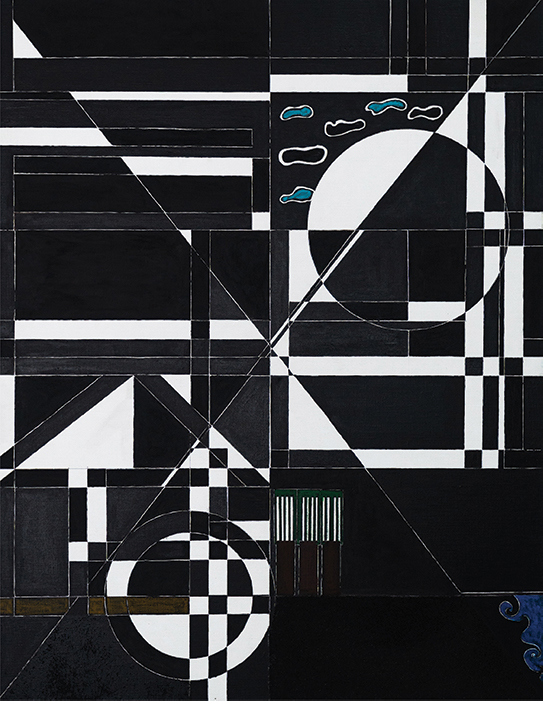 서자현, 천지창조 둘째날, Acrylic on Canvas, 116.8×91cm, 2020
서자현, 천지창조 둘째날, Acrylic on Canvas, 116.8×91cm, 2020
[전시서문]
수평과 수직, 사각형으로 보는 종교적 사유
서자현의 보는 것
백지연 독립 큐레이터
‘본다’는 것의 의미
인간이 ‘본다’는 것, ‘의식’한다는 것은 무엇을 의미할까? 이번 전시의 제목이자 서자현 작가가 지속해서 고민해 온 ≪보는 것과 보여지는 것≫에 대한 깊은 통찰은 개인과 사회, 정치, 과학, 종교적 상호 작용에 배경을 두고 있다. 본다는 것을 생물학적으로 이해한다면, 망막으로 들어온 빛을 전기적 신호로 바꾸고, 그것을 뇌에 전달하는 형체를 알아보는 일이다. 예를 들어, 우리가 나무를 봤을 때 뇌에 전해지는 나무는 일종의 전기적 신호다. 그렇다면, 뇌에 전해진 전기적 신호가 어떻게 나무라는 실체로 ‘의식’할 수 있을까? 물리적인 뇌에 물리적이지 않은 ‘의식’이 작동한다는 것은 과학적으로 온전히 설명할 수 없는 부분이지만, ‘본다’는 의미가 사람 개개인의 ‘의식’에 따라 여러 가지로 해석될 수 있음을 설명해주기도 한다. 또한, 사회 정치적으로는 내가 무언가를 보는 것도 그리고 무언가를 보게 해준 것도 우리가 속한 공동체 안에서 지식과 욕망, 권력으로 연결되기도 한다. 우리가 실시간으로 ‘내가 지금 보는 것’을 업데이트해 주변인들과 공유하는 소셜 네트워크를 예로 생각해보면 쉽게 이해할 수 있다. ‘본다’는 것이 결코 개인적일 수 없는 시대에 작가의 ‘보는 것’에 대한 사유는 감상자들에게 삶의 또 다른 이해를 제시해 줄 거라 여겨진다.
이번 전시는 서자현의 ‘보는 것’에 대한 종교적 성찰의 목소리가 중심이 되어 펼쳐진다. 믿음, 소망, 사랑, 천지창조라는 소주제 아래 예술가와 신앙인이라는 두 정체성 사이에서의 솔직한 고백과 더불어 작가의 초기작부터 최근작까지 한자리에 선보이게 된다. <보는 것과 보여지는 것> 연작은 2016년 뉴욕의 NARS(The New York Art Residency and Studios) 레지던시에 참여하면서 시작됐지만, ‘보는 것’에 대한 생각을 다각도로 하게 된 건 2004년도 아프리카를 방문하면서부터다. 미디어에서 접했던 아프리카와 직접 마주한 실재가 다른 데서 온 충격은, 보는 것’에 대한 미디어의 필터에 대해 깊이 사고하게 되는 계기가 된다. 아프리카에서 돌아온 작가는 그곳에서 촬영한 사진을 원본으로 이미지 프로세싱(image processing)을 통해 여러 방향의 의도가 담긴 또 다른 원본이자 사본을 만든다. 이 작품들은 이후 발표하게 되는<보는 것과 보여지는 것>(2016~) 연작의 출발점이 되었다.
수평선과 수직선이 향해가는 믿음, 소망, 사랑
서자현의 작업에서 두드러지게 드러나는 수평선과 수직선은 원본과 원본에서 파생된 여러 작업에서 찾아볼 수 있다. 수평선과 수직선이 교차하면 십자형이 된다. 이는 원시미술에서부터 현대미술에 이르기까지 우주와 종교, 인간을 상징하는 기호로서 존재해 왔으며, 심리적 치유와 종교적 구원을 암시하기도 했다. 예를 들어, 기독교의 십자가나, 고대 미술과 공예품에서 볼 수 있는 격자무늬 도자기, 옷감과 바구니 등의 날실과 씨실 구조 등에서 발견할 수 있으며, 현대미술에 이르러서는 기하학적 추상과 미니멀리즘에 등장하는 그리드(grid: 격자)에서 볼 수 있다. <보는 것과 보여지는 것>(2016~) 연작의 원형 작업이 되는 캔버스 작품을 살펴보면 마스킹 테이프(masking tape: 얇은 종이테이프)와 아크릴 물감이 수직과 수평으로 붙여지고 그려져 있는 중첩된 구조를 볼 수 있다. 작가는 수평선과 수직선으로 만들어지는 사각의 공간에 물감을 바르고, 마스킹 테이프를 붙이고, 또다시 물감을 덧바르는 행위를 반복하며 입체적인 사각의 작업을 원본으로 삼는다. 그리고 원본이 된 작품을 촬영하여 디지털 작업을 거침으로써 수십장의 변형된 작품이 탄생한다. 원형의 캔버스 작품과 디지털로 파생된 여러 작품은 어느 것으로부터 나오게 된 작품인지 알 수 없는 형태로 전시장의 벽면에 걸리게 된다. 그리고 이들은 전시장 공간을 아우르는 검은 수평선과 수직선으로 연결이 되는데, 이는 작품이 벽면에 걸린 후 작가의 개입이 장소 특정적 설치 작업으로 투영되기 때문이다. 작가는 검은색의 마스킹 테이프를 이용해 작품들을 둘러싼 수평선과 수직선을 벽과 바닥, 천장에 구성해 나간다. 평면과 입체 작업의 프레임 속에 존재했던 수평선과 수직선은 프레임 밖을 벗어나 확장된 공간으로 뻗어 나가며 다른 작품들과 관계를 맺음으로써 거대한 하나의 설치 작업으로 선보이게 된다. 그리고 수평과 수직이 만나 직각으로 만나는 영구적이고 균형적인 선은 작가의 종교적 믿음과 소망, 사랑을 향해가는 정신적 질서를 반영한다.
수평과 수직의 시공간 사각형, 천지창조
수평과 수직으로 시작한 두 선이 교차하여 십자형이 되고, 십자형은 확장되어 사각의 시공간이 된다. 사각형은 서자현의 작품에서 생성되는 종착점이자 또 다른 시작점이 되기도 하며, 작가 자신을 대변하는 메타포가 되기도 한다. 사각형이 작품 안으로 들어오게 된 건, 그의 인생이 사각형 안에서만 이뤄진 것 같은 힘든 시기를 겪게 되면서다. 당시 작가는 내면의 둥근 심장마저 생명이 다해가는 사각의 심장으로 느껴졌다고 한다. 어두운 터널을 지난 지금의 그에게 사각형은 깨지지 않는 강한 자아이자, 고요와 휴식을 얻을 수 있는 공간이지만, 힘든 시기에 작가가 느꼈을 사각형은 벗어나고 싶지만 벗어날 수 없는 미로였을 것이다. 서자현의 최근 작업인 <사각 틀>(2020)은 그가 현재 바라보는 강한 자아로서의 사각형을 입체로 표현하고 있다. 작품은 육면체가 아닌 두 면이 뚫려있는 사면체의 프레임 형태로 제작되었다. 그의 작업은 많은 수가 정사각의 형태를 지니고 있는 공통점이 있지만, 이들은 언제나 개방의 구조를 취하고 있다. 평면 작업은 벽과 바닥, 천장에 그어진 검은 테이핑의 선 설치 작업으로 해방된 시공간을 마주하게 되며, 입체 작업 또한 정육면체가 아닌 직경 1m의 검은 프레임으로 만들어져 작품들끼리의 열린 구조를 형성했다. 여기에 퍼포머의 참여가 이뤄진 영상 작업은 작가가 말하고자 하는 종교적 고백을 좀 더 입체적인 방법으로 이끌어내고 있다. 서양의 기하학에서 우주의 질서를 상징하기도 하는 사각형은 서자현의 <천지창조>(2020) 연작에서 더욱더 세밀하게 구획되어 표현된다. 미켈란젤로(Michelangelo)의 <천지창조>(1508~1512) 중 가장 잘 알려진 장면인 ‘아담의 창조’ 이미지를 빌려와 하나님과 아담의 손가락이 닿으려는 순간을 사각 틀로 다양하게 변주하는가 하면, 성경에 나오는 7일 동안의 천지창조 서사를 일곱 폭의 캔버스에 그려 넣었다. 여기서 서자현은 수평과 수직, 사각형뿐 아니라 원과 삼각의 형태를 처음으로 등장시키는데, 이것은 천지창조의 내용을 은유함과 동시에 주변의 비가시적인 정신적 요소들에 대한 환유적 표현이라 볼 수 있다.
보이지 않는 것을 보는 것
전시장의 수많은 수평선과 수직선 그리고 사각형은 ‘보는 것’에 대한 작가의 개인적이고 종교적인 심상을 대변해주고 있다. 원본이 사본이 되고 사본이 원본이 되는 가운데 결국 보는 이의 의식에 따라 종교 또한 다르게 보이고 해석될 수 있음을 상기시킨다. 지금까지 ‘보는 것’에 대해 지속적인 질문을 해왔던 서자현은 보이지 않는 것, 본질적이며 쉽게 볼 수 없는 이면에 존재하는 것을 보는 것이 무엇인지를 되물으며 그의 작업의 원형을 환기해 준다. 우리를 둘러싼 사각형이 꽉 차 있는 것 같기도 하고, 텅 빈 것 같기도 한 이유다.
 서자현, 천지창조 셋째날, Mixed media, 116.8×91cm, 2020
서자현, 천지창조 셋째날, Mixed media, 116.8×91cm, 2020
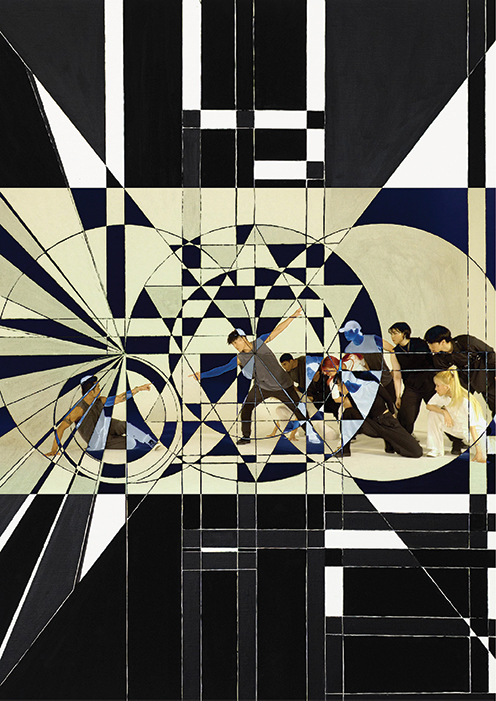 서자현, 천지창조 넷째날, Mixed media, 116.8×91cm, 2020
서자현, 천지창조 넷째날, Mixed media, 116.8×91cm, 2020
Religious Causes of Seeing in Horizontals, Verticals and Quadrangles
Seeing by Jahyun Seo
Jiyeon Paik, Independent Curator
The Definition of ‘Seeing’
What does it mean for humans to ‘see’ and ‘perceive’ something? Artist Jahyun Seo has been contemplating what <Seeing and Being Seen> are, which is also the title of the exhibit. Her deep thoughts on the theme is based on individual, social, political, scientific and religious interactions. In biological terms, the act of seeing refers to the process in which light comes through the retina and is converted into an electrical signal, then delivered to the brain for the brain to recognize the shape. For example, when we see a tree, the tree the brain recognizes is some type of an electrical signal. Then how does the electrical signal delivered to the brain ‘be perceived’ as a tree? Having non-physical ‘perception’ working in the physical brain requires more than scientific explanation; however, this also means the definition of ‘seeing’ can be interpreted in so many ways depending on each individual’s ‘perception’. Moreover, in sociopolitical terms, what I see and what has enabled me to see can be connected to knowledge, desire and power within the community we are part of. Social media is a good example, as we update and share real-time on social media ‘what we are seeing’ with others. In today’s world where ‘to see’ cannot be personal, the artist’s contemplation of ‘seeing’ is expected to offer another understanding of life for the audience.
The exhibit unfolds with the artist’s voice of religious thinking on ‘seeing’ at the center. Under the subthemes of faith, wish, love and the Creation, the artist candidly expresses her identities as both an artist and a religious believer, with her first artwork to the latest one all showcased in one place. The art series <Seeing and Being Seen> first took off at the New York Art Residency and Studios Foundation’s residency program; but it was in 2004 when Seo began to take multi-angular views on ‘seeing’ after visiting Africa. The Africa she knew from the media and actual Africa she saw with her own eyes were very different, and the shock that came with the realization gave her an opportunity to reflect upon the media’s filters. After coming back from Africa, she created a set of originals and copies with multi-directional purposes by performing image processing on the original photos she took there. Her works marked the starting point of her future series <Seeing and Being Seen> (2016-).
Faith, Wish and Love - Where Horizontal and Vertical Lines are Headed
In Seo’s works, horizontal lines and vertical lines stand out and can be found in the original works as well as her sequential works. When a horizontal line and vertical line intersect, they form a cross. Crosses have long been used as a symbol of the universe, religions and humans from primitive art to modern art, while also implying psychological healing and religious salvation. Crosses can be found in the Christian cross, grid pattern pottery often seen in ancient art and crafts, and warp and weft in clothes and baskets. More recently, in modern art, crosses can be seen in grids that appear in many geometric abstract art and minimalism. Seo’s canvas work, which is the original work of the art series <Seeing and Being Seen> (2016-), uses masking tape and acrylic paints that are attached to and drawn on one another, intersecting vertically and horizontally in layers. Seo painted the rectangular and square spaces created in between horizontal and vertical lines, put masking tape and painted on top of masking tape to create dimensional rectangles and squares that become the original form of her work. She takes pictures and digitally process the original form, giving birth to tens of different versions. The original canvas work and its digital byproducts are displayed on the wall, and one can’t simply figure out which one comes from which. And they are connected by black horizontal and vertical lines that cover the walls of the venue, which is because once the works are hung on the walls, the artist’s involvement is projected in the form of location-specific installation works. Seo uses black masking tape to place the horizontal and vertical lines that surround her works on the walls, floor and ceiling. The horizontal and vertical lines that existed on a flat surface and in the frames of the dimensional works now reach out to extended spaces outside of the frames and interact with other works, thereby manifesting themselves as one giant installation work. And the permanent, balanced right angle lines formed by horizontals and verticals reflect the artist’s psychological order that heads for religious faith, wish and love.
The Creation: The Quadrangular Time-space of Horizontals and Verticals
Two lines - one horizontal and one vertical - intersect to form a cross, and the cross expands to the time-space of rectangles and squares. These quadrangles serve as both a final stop and starting point created in Seo’s works, as well as a metaphor that represents the artist herself. It was during difficult times of her life when rectangles and squares came into her works. Back then, she felt her life exists only in rectangles and squares, and even her round-shaped heart felt like a rectangular heart losing life. Now out of the dark tunnel, rectangles and squares have become her powerful, unbreakable ego and a space of tranquility and rest; but at the same time, one can imagine how the shapes have formed a maze impossible to escape during her tough times. Seo’s recent work <Rectangular Frame> (2020) expresses the shapes - her powerful ego - she’s seeing in dimensions. The work is in a tetrahedral frame with two open sides, rather than a cube. Her works are mostly square, but always open. Her flat surface work involves an installation of lines formed with black masking tape on the walls, floor and ceiling, which allows the audience to face the open time-space. Her dimensional works are made of black frames with diameters of 1m, rather than cubes, to show how the works form open structures with one another. Her video work with performers visualizes her religious confession in a more dimensional manner. Rectangles and squares that represent the order of the universe in western geometry are more finely divided and expressed in her sequential work <The Creation> (2020). Seo borrows the image of ‘The Creation of Adam’, the most famous scene of <Genesis> (1508-1512) by Michelangelo, to give variations with rectangular and square frames to the moment Adam’s finger is about to touch God’s finger. She also painted the seven days of the Creation described in the Bible in seven canvases. Here, Seo introduces circles and triangles for the first time along with horizontals, verticals, rectangles and squares. They suggest a metonymic expression of the surrounding invisible psychological elements, while metaphorizing the contents of the Creation.
Seeing the Invisible
The many horizontal and vertical lines, rectangles and squares represent the artist’s personal and religious image of ‘seeing’. Originals become copies, copies become originals: during the process, religion takes different forms and gives rise to various interpretations depending on the perception of the person seeing it. Seo, who has continuously questioned what it is to ‘see’, ceaselessly asks what it means to see what exists on the other side - a side that is both fundamental and difficult-to-see -, thereby awakening the originals of her works. That is why the rectangles and squares surrounding us seem filled and all empty at the same time.

